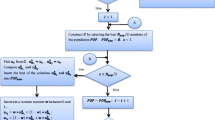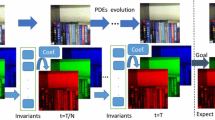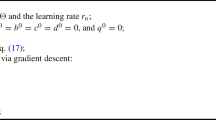Abstract
Selecting appropriate terms to design partial differential equations (PDEs) for specific processing and vision tasks have a prominent role in achieving acceptable results. In this paper, we present an automatic method to obtain a set of suitable terms of PDE for specific processing and vision tasks. Therefore, a new optimization framework has been constructed which is constrained with PDEs in the form of linear combinations of differential terms with time-independent coefficients, and is solved through training data. The optimization problem could be solved by translating it to a least square problem through the assumption of independency of time. By this assumption, it is possible to select any arbitrary term for the PDE and blend different PDEs for processing tasks, including image denoising. Several numerical experiments in image denoising prove the present model robust to the size of data and the kind of its noise.










Similar content being viewed by others
Explore related subjects
Discover the latest articles, news and stories from top researchers in related subjects.References
Aubert G, Kornprobst P (2001) Mathematical Problems in Image Processing. Partial Differential Equations and the Calculus of Variations. Springer, New York
Gabor D (1965) Information theory in electron microscopy. Lab Invest 14:801–807
Koenderink J (1984) The structure of images. Biol Cybern 50:363–370
Perona P, Malik J (1990) Scale-space and edge detection using anisotropic diffusion. IEEE Trans Pattern Anal Mach Intell 12:629–639
Catte F, Lions PL, Morel JM, Coll T (1992) Image selective smoothing and edge detection by nonlinear diffusion. SIAM J Numer Anal 29:845–866
Weickert J (1999) Coherence-enhancing diffusion filtering. Int J Comput Vis 31:111–127
Weickert J (1998) Anisotropic diffusion in image processing. University of Copenhagen Denmark Press
Rudin L, Osher S, Fatemi E (1992) Nonlinear total variation based noise removal algorithms. Phys D 60:259–268
Chan TF, Golub GH, Mulet P (1999) A nonlinear primal-dual method for total variation based image restoration. SIAM J Sci Comput 20:1964–1977
Chan T, Esedoglu S (2005) Aspects of total variation regularized L1 function approximation. SIAM J Multiscale Model Simul 65:1817–1837
Gilboa G, Soche N, Zeevi Y (2006) Variational denoising of partly textured images by spatially varying constraints. IEEE Trans Image Process 15:2281–2289
Aubert G, Vese LA (1997) A variational method in image recovery. SIAM J Numer Anal 34:1948–1979
Li W, Li Q, Gong W (2012) Total variation blind deconvolution employing split Bregman iteration. J Vis Commun Image Represent 23:409–417
Wang Y, Chen WF, Zhou SJ (2011) MTV: modified total variation model for image noise removal. IEE Electron Device Lett. 47:592–594
Li F, Shen C, Liu R, Fan J (2011) A fast implementation algorithm of TV inpainting model based on operator splitting method. Comput Electr Eng 37:782–788
Chan T, Marquina A, Mulet P (2000) High order total variation-based image restoration. SIAM J Sci Comput 22:503–516
Lysaker M, Osher S, Tai XC (2004) Noise removal using smoothed normals and surface fitting. IEEE Trans Image Process 13:1345–57
Lysaker M, Lundervold A, Tai XC (2003) Noise removal using fourth-order partial differential equation with applications to medical magnetic resonance images in space and time. IEEE Trans Image Process 12:1579–1590
Lysaker M, Tai XC (2006) Iterative image restoration combining total variation minimization and a second-order functional. Int J Comput Vis 66:5–18
Blomgren P, Chan TF, Mulet P (1997) Extensions to total variation denoising. In: Proceedings society of photo-optical instrumentation engineers SPIE, San Diego
Jidesh P, George S (2012) Shock coupled fourth-order diffusion for image enhancement. Comput Electr Eng 38:1262–1277
Li F, Shen C, Fan J (2007) Image restoration combining a total variational filter and a fourth-order filter. J Vis Commun Image Represent 18:322–330
Wang H, Wang Y, Ren W (2012) Image denoising using anisotropic second and fourth order diffusions based on gradient vector convolution. Comput Sci Inf Syst 9:1493–1511
You YL, Kaveh M (2000) Fourth-order partial differential equations for noise removal. IEEE Trans Image Process 9:1723–1730
Liu R, Lin Z, Zhang W, Su Z (2010) Learning PDEs for image restoration via optimal control. In: European conference on computer vision, 115–128
Lin Z, Zhang W, Tang X (2008) Learning partial differential equations for computer vision. Technical report, Microsoft Research
Liu R, Lin Z, Zhang W, Tang K, Su Z (2013) Toward designing intelligent PDEs for computer vision: an optimal control approach. Image Vis Comput 31:43–56
Zhao Z, Jiaoy Y, Hou C, Wu Y (2016) Learning partial differential equations for saliency detection. In: IEEE international conference on big data analysis (ICBDA)
Jiao Y, Pan X, Zhao Z, Hou C (2018) Learning sparse partial differential equations for vector-valued images. Neural Comput Appl 29:120–1216
Fang C, Zhao Z, Zhou P, Lin Z (2017) Feature learning via partial differential equation with applications to face recognition. Pattern Recogn 69:14–25
Moorthi S, Karthikeyan S (2018) A study on learning partial differential equations algorithm for face recognition. Int J Innov Res 5:2347–6060
Tikhonov AN, Arsenin VY (1977) Solutions of ill-posed problems. Winston and Sons, Washington
Aubert G, Vese L (1997) A variational method in image recovery. SIAM J Numer Anal 34:1948–1979
Vese L (1996) Problemes variationals et EDP pour lanalyse dimages et levolution de courbes. PhD thesis, Universite de Nice Sophia-Antipolis
Olver P (1993) Applications of lie groups to differential equations. Springer
Kim D, Fessler JA (2016) Optimized first-order methods for smooth convex minimization. Math Prog 151:81–107
Gabay D, Mercier B (1976) A dual algorithm for the solution of nonlinear variational problems via finite-element approximations. Camput Math Appl 2:17–40
Acknowledgments
The authors would like to thank the anonymous reviewers for their useful suggestions and valuable comments which were greatly helpful to improve the quality of this paper.
Author information
Authors and Affiliations
Corresponding author
Ethics declarations
Conflict of interest
The authors declare that they have no conflict of interest.
Additional information
Publisher's Note
Springer Nature remains neutral with regard to jurisdictional claims in published maps and institutional affiliations.
Rights and permissions
About this article
Cite this article
Ashouri, F., Eslahchi, M.R. A new PDE learning model for image denoising. Neural Comput & Applic 34, 8551–8574 (2022). https://doi.org/10.1007/s00521-021-06620-4
Received:
Accepted:
Published:
Issue Date:
DOI: https://doi.org/10.1007/s00521-021-06620-4




